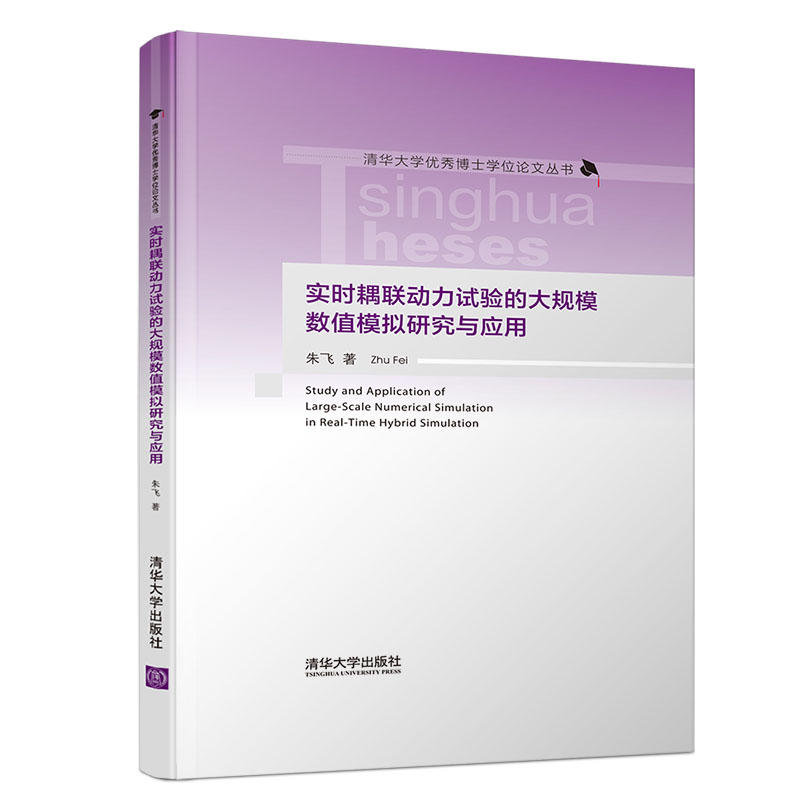
清华大学很好博士学位论文丛书实时耦联动力试验的大规模数值模拟研究与应用

- ISBN:9787302520955
- 装帧:一般胶版纸
- 册数:暂无
- 重量:暂无
- 开本:其他
- 页数:209
- 出版时间:2018-06-01
- 条形码:9787302520955 ; 978-7-302-52095-5
本书特色
本书系统阐述了实时耦联动力试验方法(RTHS)的基本原理与研究现状,以及基于清华大学实时耦联动力试验系统开展的一系列创新性理论研究与试验应用成果。 全书分为8章,包括绪论、基于双目标机的RTHS系统构建及验证、多自由度RTHS系统的时滞稳定性分析、不同数值积分算法的时滞稳定性和精度分析、调谐液柱阻尼器的减震性能研究、调谐液柱阻尼器在高层结构减震中的应用试验、调谐液体阻尼器关键问题研究、结论与展望。 本书可供结构抗震领域科研技术人员参考,也可作为水利工程、土木工程及相关专业师生的参考书。
内容简介
本书系统阐述了实时耦联动力试验方法(RTHS)的基本原理与研究现状,以及基于清华大学实时耦联动力试验系统开展的一系列创新性理论研究与试验应用成果。 全书分为8章,包括绪论、基于双目标机的RTHS系统构建及验证、多自由度RTHS系统的时滞稳定性分析、不同数值积分算法的时滞稳定性和精度分析、调谐液柱阻尼器的减震性能研究、调谐液柱阻尼器在高层结构减震中的应用试验、调谐液体阻尼器关键问题研究、结论与展望。 本书可供结构抗震领域科研技术人员参考,也可作为水利工程、土木工程及相关专业师生的参考书。
目录
第1章绪论
1.1工程背景与研究意义
1.2实时耦联动力试验技术
1.2.1传统动力试验方法
1.2.2实时耦联动力试验
1.3实时耦联动力试验研究进展
1.3.1试验系统的发展
1.3.2数值积分算法
1.3.3时滞及时滞补偿算法
1.3.4时滞稳定性分析
1.3.5非线性数值子结构的求解
1.3.6试验应用
1.4调谐液柱阻尼器
1.4.1数值与试验研究
1.4.2工程应用
1.5本书的主要工作与创新点
1.5.1本书的主要工作
1.5.2本书的创新点
第2章基于双目标机的RTHS系统构建及验证
2.1引论
2.2清华大学RTHS系统
2.3双目标机RTHS系统构建
2.3.1数值子结构计算的任务分解策略及应用
2.3.2位移外插及内插策略
2.4双目标机RTHS系统的数值验证
2.4.1计算精度
2.4.2计算能力
2.5双目标机RTHS系统的试验验证
2.5.1单层钢架有限元地基模型
2.5.2试验结果
2.6基于双显式数值积分算法的时滞补偿法
2.6.1双目标机RTHS系统中的反馈力协调性问题
2.6.2补偿算法的提出及特性分析
2.6.3数值算例验证
2.6.4RTHS试验验证
2.7本章小结
第3章多自由度RTHS系统的时滞稳定性分析
3.1引论
3.2基于离散根轨迹法的时滞稳定性分析模型
3.2.1离散根轨迹法
3.2.2多自由度RTHS系统时滞稳定性分析模型
3.3两自由度结构的RTHS系统时滞稳定性分析
3.3.1失稳机理分析
3.3.2参数影响分析
3.3.3考虑不同时滞补偿算法的稳定性分析
3.4时滞稳定性的RTHS验证
3.4.1考虑有限元数值子结构及单源时滞
3.4.2考虑有限元数值子结构及多源时滞
3.5本章小结
第4章不同数值积分算法的时滞稳定性和精度分析
4.1引论
4.2不同数值积分算法在RTHS系统中的特性变化
4.2.1典型数值积分算法简介
4.2.2理论分析
4.3数值算法的时滞稳定性分析
4.3.1纯时滞条件下的时滞稳定性分析
4.3.2考虑时滞补偿的时滞稳定性分析
4.4数值算法的时滞精度分析
4.4.1基于数值模拟的精度分析
4.4.2基于离散根轨迹的精度分析
4.5数值算法时滞稳定性和精度的RTHS验证
4.6本章小结
第5章调谐液柱阻尼器的减震性能研究
5.1引论
5.2TLCD减震机理
5.2.1单自由度结构TLCD系统动力方程
5.2.2参数影响分析
5.3TLCD减震控制的RTHS验证
5.3.1试验思路
5.3.2试验模型
5.3.3结构TLCD系统的稳定性分析
5.3.4基于RTHS的TLCD减震试验
5.4基于RTHS的TLCD参数影响分析
5.4.1质量比
5.4.2结构阻尼比
5.4.3结构刚度变化
5.4.4地震加速度峰值
5.5MTLCD用于单自由度钢架的减震控制
5.6本章小结
第6章调谐液柱阻尼器在高层结构减震中的应用试验
6.1引论
6.2多自由度结构TLCD系统动力方程
6.2.1多自由度结构STLCD系统
6.2.2多自由度结构MTLCD系统
6.3足尺TLCD结构地基系统的RTHS试验方法
6.4试验模型
6.4.1九层Benchmark钢结构
6.4.2足尺TLCD模型
6.5STLCD控制的RTHS试验
6.5.1STLCD动力特性
6.5.2试验结果及分析
6.6MTLCD控制的RTHS试验
6.6.1MTLCD控制一阶振型响应
6.6.2MTLCD控制多阶振型响应
6.7考虑结构地基相互作用的RTHSTLCD试验
6.7.1试验框架
6.7.2考虑有限地基SSI效应
6.7.3考虑半无限地基SSI效应
6.8本章小结
第7章调谐液体阻尼器关键问题研究
7.1引论
7.2基于RTHS的TLD非线性刚度阻尼模型验证
7.2.1非线性刚度阻尼模型
7.2.2RTHS试验验证
7.3TLD几何尺寸效应影响研究
7.3.1考虑几何尺寸效应的试验结果
7.3.2考虑质量比尺的试验结果
7.4TLD与TLCD减震效果对比
7.4.1试验模型
7.4.2试验结果
7.5本章小结
第8章结论与展望
8.1主要研究成果和结论
8.2研究展望
参考文献在学期间发表的学术论文与研究成果致谢Contents实时耦联动力试验的大规模数值模拟研究与应用
Contents
Chapter 1Introduction
1.1Background and Research Significance
1.2RealTime Hybrid Simulation Technique
1.2.1Traditional Structural Dynamic Experiments
1.2.2RealTime Hybrid Similation
1.3Review of RealTime Hybrid Simulation
1.3.1Development of Experimental System
1.3.2Numerical Algorithms
1.3.3Time Delay and Compensation Methods
1.3.4DelayDependent Stability Analysis
1.3.5Nonlinear Numerical Substructure
1.3.6Application
1.4Tuned Liquid Column Damper
1.4.1Numerical and Experimental Study
1.4.2Practical Application
1.5Research Content and Highlight
1.5.1Research Content
1.5.2Highlight
Chapter 2Construction and Verification of RTHS System Based on Dual
Target Computers
2.1Introduction
2.2RTHS System in Tsinghua University
2.3Construction of RTHS System Based on Dual Target
Computers
2.3.1Task Splitting Strategy in Numerical Substructure
Analysis
2.3.2Displacement Extrapolation and Interpolation
2.4Numerical Verification
2.4.1Computational Accuracy
2.4.2Computational Capability
2.5Experimentional Verification
2.5.1Single FrameFinite Element Foundation Model
2.5.2Experimental Results
2.6Time Delay Compensation Method Based on Guiλ
Algorithn
2.6.1Incoordination between the Real and Desired
Feedback Forces
2.6.2The Proposed Time Delay Compensation Method
and Its Characteristics
2.6.3Numerical Verification
2.6.4RTHS Verification
2.7Summary
Chapter 3DelayDependent Stability Analysis of MDOFRTHS System
3.1Introduction
3.2Theoretical Model for Stability Analysis Based on
DiscreteTime Root Locus Technique
3.2.1DiscreteTime Root Locus Technique
3.2.2The Construction of Stability Analysis Model for
MDOFRTHS System
3.3DelayDependent Stability Analysis of 2 DOFs RTHS
System
3.3.1Instability Mechanism Analysis
3.3.2Parameter Impact Analysis
3.3.3Stability Analysis Considering Different TimeDelay
Compensation Methods
3.4RTHS Verification
3.4.1Finite Element Numerical Substructure with Single
Delay Source
3.4.2Finite Element Numerical Substructure with Multiple
Delay Source
3.5SummaryChapter 4Stability and Accuracy Investigation of Different Integration
Algorithms
4.1Introduction
4.2Characteristics of Different Integration Algorithms in RTHS
System
4.2.1Brief Introduction of CommonlyUsed Integration
Algorithms
4.2.2Theoretical Analysis
4.3DelayDependent Stability Analysis of Integration
Algorithms
4.3.1Consideration of Pure Time Delay
4.3.2Consideration of Time Delay Compensation
4.4DelayDependent Accuarcy Analysis of Integration
Algorithms
4.4.1Accuarcy Analysis Based on Numerical Simulation
4.4.2Accuarcy Analysis Based on DiscreteTime Root
Locus Technique
4.5RTHS Verification
4.6Summary
Chapter 5Seismic Performance Analysis of Tuned Liquid Column
Damper
5.1Introduction
5.2Absorption Principle of TLCD
5.2.1Dynamic Equation of SDOF StructureTLCD
System
5.2.2Parametic Analysis
5.3RTHS Verfication of Control Effect of TLCD
5.3.1Experimental Method
5.3.2Experimental Model
5.3.3Stability Analysis of StructureTLCD System
5.3.4RTHS of StructureTLCD System
5.4Parametic Analysis of TLCD Based on RTHS
5.4.1Mass Ratio
5.4.2Structural Damping Ratio
5.4.3Structural Stiffness
5.4.4Peak Ground Acceleration
5.5Application of Applying MTLCD to Control SDOF Frame
5.6Summary
Chapter 6Experimental Study of Dynamic Response of HighRise
Structure under TLCD Control
6.1Introduction
6.2Dynamic Equation of MDOF StructureTLCD System
6.2.1MDOF StructureSTLCD System
6.2.2MDOF StructureMTLCD System
6.3RTHS Method of FullScale TLCDStructureFoundation
System
6.4Experimental Model
6.4.1NineStory Benchmark Steel Structure
6.4.2FullScale TLCD Model
6.5RTHS of STLCD
6.5.1Dynamic Characteristic of STLCD
6.5.2Expeimental Results
6.6RTHS of MTLCD
6.6.1Using MTLCD Control the FirstOrder Modal
Response
6.6.2Using MTLCD Control the MultiOrder Modal
Response
6.7RTHSTLCD Considering SoilStructure Interaction
6.7.1Experimental Framework
6.7.2Considering SSI in Finite Foundation
6.7.3Considering SSI in SemiInfinite Foundation
6.8Summary
Chapter 7Key Issue Study of Tuned Liquid Damper
7.1Introduction
7.2RTHS Verfication of Nonlinear StiffnessDamping Model
for TLD
7.2.1Nonlinear StiffnessDamping Model
7.2.2RTHS Verification
7.3Investigation of Size Effect of TLD
7.3.1Experiment Considering Size Effect
7.3.2Experiment Considering Mass Ratio Effect
7.4Comparison of Control Effect Between TLD and TLCD
7.4.1Experimental Model
7.4.2Experimental Results
7.5Summary
Chapter 8Conclusion and Prospect
8.1The Main Research Result and Conclusion
8.2Prospect
-

AI绘画+AI摄影+AI短视频从入门到精通
¥45.5¥79.8 -

企业AI之旅
¥43.5¥79.0 -

乡村振兴新技术:新时代农村短视频编辑技术基础入门
¥12.8¥32.0 -

机器学习
¥59.4¥108.0 -

基于知识蒸馏的图像去雾技术
¥61.6¥88.0 -

粒子群算法在优化选取问题中的应用研究
¥40.8¥68.0 -

Web前端开发基础
¥36.5¥57.0 -

智能算法优化及其应用
¥49.0¥68.0 -

Photoshop图像处理
¥25.5¥49.0 -

R语言医学数据分析实践
¥72.3¥99.0 -

大模型推荐系统:算法原理、代码实战与案例分析
¥66.8¥89.0 -

剪映 从入门到精通
¥25.7¥59.8 -

游戏造梦师----游戏场景开发与设计
¥68.6¥98.0 -

SAR图像处理与检测
¥35.4¥49.8 -

生成式人工智能(AIGC)应用
¥71.1¥90.0 -

人工智能
¥29.4¥42.0 -

中文版PHOTOSHOP 2024+AI修图入门教程
¥59.3¥79.0 -

WPS办公软件应用
¥25.2¥36.0 -

格拉斯曼流行学习及其在图像集分类中的应用
¥13.7¥28.0 -

轻松上手AIGC:如何更好地向CHATGPT提问
¥40.3¥62.0










